- Joined
- Nov 17, 2013
- Messages
- 2,560
Karl_K|1387300277|3576168 said:The top six things affecting the look of any diamond are:
lighting
lighting
lighting
lighting
lighting
cut
Hahaha! I love it.
Karl_K|1387300277|3576168 said:The top six things affecting the look of any diamond are:
lighting
lighting
lighting
lighting
lighting
cut
Texas Leaguer|1387301431|3576180 said:One would think Tourmaline's diamond is drawing alot of low angle light in order to be reflecting the wall colors so dramatically. (Unless the ceiling is also painted the same color or photo is shot with hand perpendicular to the ceiling).
Very interesting collage.
Karl_K|1387300277|3576168 said:no,
The top six things affecting the look of any diamond are:
lighting
lighting
lighting
lighting
lighting
cut
Texas Leaguer|1387301431|3576180 said:Karl_K|1387300620|3576172 said:AGS far underestimates the effect of low angle lighting.Rhino|1387297781|3576129 said:Based on the studies of optical scientist Jose Sasian who worked with AGS to refine their ASET technology, the theory states that light entering from the 0-45 degree angular spectrum (green in ASET) is weak ... dull illumination as light bouncing off of walls is not bright nor as intense as light entering from the 45-75 degree angular spectrum (red in ASET). Hence dull in = dull out.
Rhino
Many people spend much of their day or should I say evening where low angle lighting is the brightest lighting.
One would think Tourmaline's diamond is drawing alot of low angle light in order to be reflecting the wall colors so dramatically. (Unless the ceiling is also painted the same color or photo is shot with hand perpendicular to the ceiling).
Very interesting collage.
needs to be ungeeked and add That some cuts by design have have areas of minor leakage which can increase contrast in a positive way.Rhino|1387303204|3576211 said:Karl, Garry ... based on what we've gone over in this last topic, do you think these would be an accurate statements? If not how would you refine?
"The length of light rays in a diamond or the more it will refract within the diamond will cause color entrapment thus making a diamond face up to a stronger tonal color than how it may be graded in the face down position.
At the same time, while ideal cut diamonds appear whiter than their non ideal counterparts they will not necessary have color entrapment but will be perceived to be a lower color merely due to the fact that the ideal cut is reflecting back more bright white reflections than the non ideal. The areas of blatant leakage showing the color behind the diamond, while areas of secondary leakage showing a gray tonal colors.
Thoughts?
What combo of red/green is best for earrings?Karl_K|1387300620|3576172 said:AGS far underestimates the effect of low angle lighting.Rhino|1387297781|3576129 said:Based on the studies of optical scientist Jose Sasian who worked with AGS to refine their ASET technology, the theory states that light entering from the 0-45 degree angular spectrum (green in ASET) is weak ... dull illumination as light bouncing off of walls is not bright nor as intense as light entering from the 45-75 degree angular spectrum (red in ASET). Hence dull in = dull out.
Rhino
Many people spend much of their day or should I say evening where low angle lighting is the brightest lighting.
With the laws mandating cfl it is also very flat and soft light in many cases.
Perfect lighting for omc/oec or other cuts that take advantage of it(*cough* Octavia).
The omc and oec were designed for low level soft lighting that was prevalent in their day.
I would think so also.Rhino|1387303870|3576221 said:I was thinking her diamond may produce considerable red in ASET
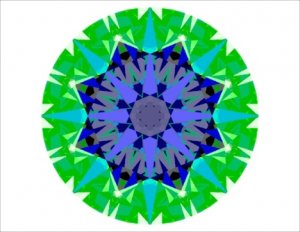
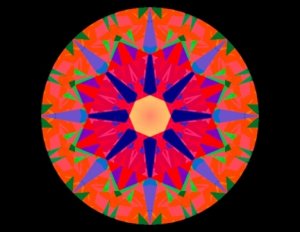
If I was designing a design for earrings I would as much as possible draw light from the red/green border region making sure to have strong green region draw in the red areas.JulieN|1387317415|3576355 said:What combo of red/green is best for earrings?
Rhino|1387303204|3576211 said:Karl, Garry ... based on what we've gone over in this last topic, do you think these would be an accurate statements? If not how would you refine?
"The length of light rays in a diamond or the more it will refract within the diamond will cause color entrapment thus making a diamond face up to a stronger tonal color than how it may be graded in the face down position.
Jon inside the diamond the light is reflecting around, and sometimes small amounts 'refract out'. The internal reflections work like the difference between looking thru the side of a very tall glass of orange juice vs looking down from the top. When refraction happens (light is inside the critical angle of 24.5 degrees) there is a portion of the light escapes. Never all of the light can escape - at 90 degrees internal bounce 83% of the ray will exit but 17% will still reflect back inside the gem. If that happens then the ray could exit out the crown, and possibly in the direction of a light source, and so be brighter, or out the pavilion and be duller, darker, greyer or browner.
At the same time, while ideal cut diamonds appear whiter than their non ideal counterparts they will not necessary have color entrapment but will be perceived to be a lower color merely due to the fact that the ideal cut is reflecting back more bright white reflections than the non ideal. The areas of blatant leakage showing the color behind the diamond, while areas of secondary leakage showing a gray tonal colors.
I do not know what the definition of blatant and secondary leakage is Jon? All ideal cut diamonds leak. In the image you can see around 20% leakage in a default DC ideal cut.
Thoughts?
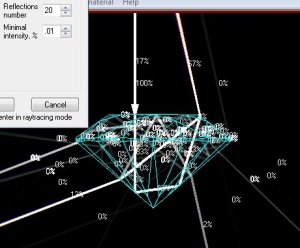
sonomacounty|1387230240|3575577 said:Aww, thanks Yssie.
Thanks Jon. Yes, you did a video of it after you sent it out to have it repolished and the girdle cleaned up. You realize this stone/ring is hanging out at your shop right now, yes?
My ideal diamond would be one with the color of this old vintage (maybe even a bit more color), cut as a AVC (they truly have superior performance), with very strong florescence.
Demon: The collection of yours that you just described - wow.
Karl_K|1387320136|3576383 said:In an earring the obstruction would be reduced and the blue zone smaller and less intense.
Garry, any opinion on what degree of obstruction to use in simulating earrings?
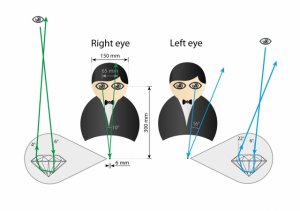
30 so 10 degrees less.JulieN|1387335903|3576567 said:What was it above, 30? 35? That looks like a huge difference.
Garry H (Cut Nut)|1387318724|3576364 said:Rhino|1387303204|3576211 said:Karl, Garry ... based on what we've gone over in this last topic, do you think these would be an accurate statements? If not how would you refine?
"The length of light rays in a diamond or the more it will refract within the diamond will cause color entrapment thus making a diamond face up to a stronger tonal color than how it may be graded in the face down position.
Jon inside the diamond the light is reflecting around, and sometimes small amounts 'refract out'. The internal reflections work like the difference between looking thru the side of a very tall glass of orange juice vs looking down from the top. When refraction happens (light is inside the critical angle of 24.5 degrees) there is a portion of the light escapes. Never all of the light can escape - at 90 degrees internal bounce 83% of the ray will exit but 17% will still reflect back inside the gem. If that happens then the ray could exit out the crown, and possibly in the direction of a light source, and so be brighter, or out the pavilion and be duller, darker, greyer or browner.
At the same time, while ideal cut diamonds appear whiter than their non ideal counterparts they will not necessary have color entrapment but will be perceived to be a lower color merely due to the fact that the ideal cut is reflecting back more bright white reflections than the non ideal. The areas of blatant leakage showing the color behind the diamond, while areas of secondary leakage showing a gray tonal colors.
I do not know what the definition of blatant and secondary leakage is Jon? All ideal cut diamonds leak. In the image you can see around 20% leakage in a default DC ideal cut.
Thoughts?
Garry H (Cut Nut)|1387339372|3576605 said:I understand Jon, but don't think we need another new definition - mainly because its almost impossible to define a boundary.
In the example I posted above for you, there is plenty of that going on in a well proportioned round brilliant. So a well cut round has both primary and secondary leakage.
Give me a model of your best stone and I will show you.
You did get SS's message with a new DC hasp download for Windows 8?
I sent you a message to your Rhinosrocks address
Send it to me also please.Rhino|1387339836|3576611 said:Garry H (Cut Nut)|1387339372|3576605 said:I understand Jon, but don't think we need another new definition - mainly because its almost impossible to define a boundary.
In the example I posted above for you, there is plenty of that going on in a well proportioned round brilliant. So a well cut round has both primary and secondary leakage.
Give me a model of your best stone and I will show you.
You did get SS's message with a new DC hasp download for Windows 8?
I sent you a message to your Rhinosrocks address
Got it. When I'm in tomorrow I'll forward you a most awesome model.
They are optimized just not for the same thing.Texas Leaguer|1387389358|3576918 said:I have a great respect for diamond cutters in general. But when you think about some of the challenges a cutter has in maximizing overall beauty in a fancy color, it really goes to another level.
Karl_K|1387344513|3576647 said:Send it to me also please.Rhino|1387339836|3576611 said:Garry H (Cut Nut)|1387339372|3576605 said:I understand Jon, but don't think we need another new definition - mainly because its almost impossible to define a boundary.
In the example I posted above for you, there is plenty of that going on in a well proportioned round brilliant. So a well cut round has both primary and secondary leakage.
Give me a model of your best stone and I will show you.
You did get SS's message with a new DC hasp download for Windows 8?
I sent you a message to your Rhinosrocks address
Got it. When I'm in tomorrow I'll forward you a most awesome model.

Karl_K|1387405704|3577081 said:based on the scan of a real diamond.
Blue to near blue is direct leakage, green and greenish blue are reflections of what is behind the diamond that has traveled through the diamond a greater distance.
One would have thought the leakage at the edge would be direct from the bottom and the arrow shapes would be more drawn from the opposite rear, however ......
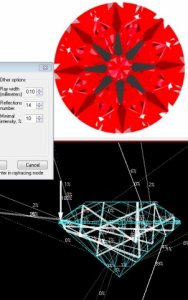
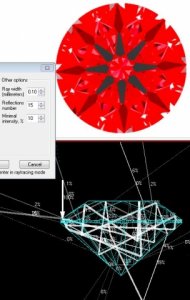
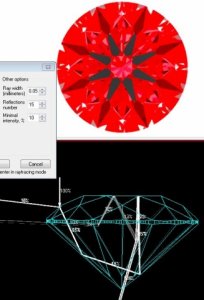
Garry H (Cut Nut)|1387413686|3577153 said:Stone rotated so the ray passes thru one of the small 8 leakage zones at the tips of the star facets. Jon you might have thought this is primary leakage.
But you will need to make a rule
e.g. when more than half the light entering or leaving exits the pavilion within X number of bounces (or whatever).
Let me know when you have a definition and I will ask Sergey why it won't work.... hahahaha
c-k|1387294581|3576089 said:Tourmaline|1387288853|3576027 said:Here is a fun collage that shows the chameleon that is my L diamond. These photos are totally unedited. Top left was taken in a room with blue walls, top right in a room with pink walls, bottom left - yellow walls, bottom middle - ivory walls, bottom right - outside while snowing.
Great job...shows the real world, now would a 'D' show the same way?